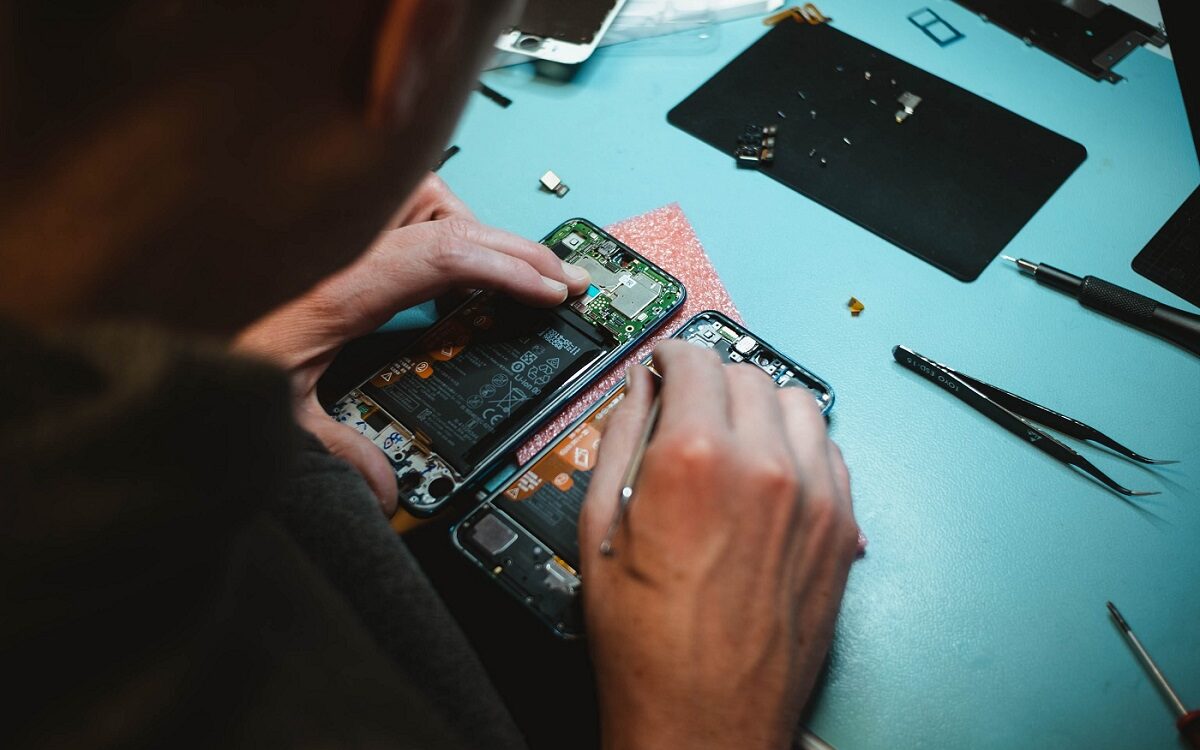Laetitia Vasseur, a doctoral student in management sciences at ESCP, founded french association HOP (Halte à l’Obsolescence Programmée, or Stop Planned Obsolescence) in 2015. What was her aim? To combat business practices that consist in artificially shortening the life of products in order to force consumers to replace with new ones. This environmentally harmful practice needed to be brought to the attention of as many people as possible and challenged in the courts.
Laetitia, first of all, can you explain to us what HOP actually does?
HOP opposes planned obsolescence, a process whereby companies deliberately limit the service life of products in order to increase their replacement rate. We tackle this phenomenon at three levels:
- Firstly, at the consumer level, in order to involve customers directly, alert them and propose alternative solutions involving sustainable products and materials.
- Secondly, at the political level, in order to regulate, improve and extend the service life of products through laws and regulations. For example, we obtained the implementation of a repairability index for certain product ranges, introduced as part of the “loi anti-gaspillage pour une économie circulaire” (anti-waste law for a circular economy) of February 2020 (editor’s note: this is a score out of ten indicating whether or not products can be easily repaired, which is mandatory for certain household appliances and electronic products).
- Finally, the third strand of our actions is to work with the companies themselves, through a sustainability club that we coordinate, and which devises solutions and objectives for tackling planned obsolescence. We have already enlisted the support of 25 firms that have pledged to help us do this.
What led you to dedicate your professional life to fighting against planned obsolescence?
In fact, I have always been passionate about consumer issues. I became aware of the problems linked to planned obsolescence by watching a documentary, and I found that it combined economic and environmental issues that particularly interested me. At that time, I was a parliamentary assistant and I submitted a proposal to legislate on the subject. My senator supported me in this process and in 2015, the amendment on the offence of planned obsolescence was adopted, which in theory prevents the artificial shortening of a product’s service life.
Is that when you decided to create HOP?
First, I went travelling for a few months and, on my return, I quit everything else to create the association. The recent introduction of the offence of planned obsolescence was an opportunity for me to support and step up the initiatives on this issue, in terms of both legal action and media exposure. At the outset, HOP was simply intended as a citizens’ initiative that I led, and in which I had enlisted the support of a few friends with expertise on the subject. But we soon attracted more volunteers, and I was able to put myself on the payroll so that I could devote myself to HOP on a full-time basis.
Did the message get through faster than expected?
There were no other associations dedicated to this issue and that is still the case, really, so I consider that we were pioneers. Quite quickly, we also benefited from a lot of media exposure. In 2015, just after the creation of the association, I wrote my first article for newspaper Libération on issues related to planned obsolescence, which explained the background to the adoption of the law. We were playing a central role in a very topical issue, and were immediately able to explain the issues at stake and the association’s activities.
“Apple was encouraging the downloading of updates that slowed down smartphones, which prompted many users to replace their devices prematurely.”
One of HOP’s biggest exploits was to file a complaint that led to Apple being fined €25 million in February 2020…
Absolutely. The brand was encouraging the downloading of updates that slowed down smartphones, which prompted many users to replace their devices prematurely.
How can the illegality of such practices be demonstrated?
Generally, an investigation report is first drawn up, whose content is determined by the human resources – both salaried and voluntary – at our disposal. Not all investigation reports lead to the filing of a complaint, but it is a possible outcome. This was the case with Apple. The fine imposed on them was negotiated in France, but the company suffered a similar financial penalty in Italy. In the United States, complaints were filed by lawyers and consumers and Apple was also convicted there. HOP remains a relatively small organisation.
You oppose the actions of large firms. Isn’t this battle too uneven?
We do not have the same resources as major companies, of course, but criminal law allows us to establish well-founded suspicions. After that, it is up to the public prosecutor to take up the matter, and the french department for fair trading, consumer affairs and fraud control (Direction générale de la Concurrence, de la Consommation et de la Répression des fraudes) to investigate. Being able to rely on government services and resources, which are neutral, facilitates our actions. Even so, some of our complaints are harder to resolve than others.

One example is the action you took against printer manufacturer EPSON in 2017. Why does the legal process take so long?
In this case, EPSON was accused of deliberately shortening the life of its ink cartridges. This complaint is still being examined. It is a very long process because it has to do with the wording of the offence itself, whose interpretation is a quite complex matter for the judges to address. In particular, it is difficult to prove the double intentionality that characterises the offence.
Double intentionality?
By double intentionality, I mean that you have to prove the intention to reduce the life of a product, as well as the intention to do so in order to increase sales.
“What if our bodies were to become products, whose capabilities could be enhanced by technology?”
Are you campaigning for more punitive legislation to effectively combat planned obsolescence?
I don’t know whether that’s the term I would use, but I’ll give you an example: recently, two complaints were lodged with the advertising standards board in order to report advertisements that were contrary to environmental values. In practice, nothing has happened, because we are not legally equipped to oppose that particular practice. Our advocacy activities include calling for better tools to battle cultural obsolescence.
Cultural obsolescence?
This is a phenomenon that accompanies planned obsolescence. Broadly speaking, cultural obsolescence consists in persuading consumers, through advertising and marketing, that they must speed up their consumption of new products, renew their equipment to keep up with changing tastes and fashions, etc. Some public and private decision-makers send out contradictory messages: on the one hand, you cannot say to the customer “consume more responsibly” and provide them with indicators such as the repairability index, and at the same time bombard them with injunctions to constantly increase their consumption. This behaviour is antagonistic in terms of the ecological impact.
Recently, you also highlighted the risk of human obsolescence. What do you mean by this?
The questions raised by transhumanism are very interesting. This can be seen with connected objects, whose power over us is growing. There is a democratic issue associated with these objects. Not least through the power they give companies, which sometimes gain a great deal of information about us and control over us via these products and in relation to them. The question is: what if our bodies were to become products, whose capabilities could be enhanced by technology? Our outer shells would then become dependent on perpetual technical innovations. I believe that it is absolutely essential to examine these potentially new forms of obsolescence.

Laetitia Vasseur is a PhD student at ESCP Business School. She is interested in product lifespan, responsible and collaborative consumption, public issues, the circular economy and its organisations. Laetitia Vasseur co-founded and runs HOP.
This interview was conducted by Adrien Candau and published (in French) in issue 195 of ESCP Alumni Magazine.
License and Republishing
The Choice - Republishing rules
We publish under a Creative Commons license with the following characteristics Attribution/Sharealike.
- You may not make any changes to the articles published on our site, except for dates, locations (according to the news, if necessary), and your editorial policy. The content must be reproduced and represented by the licensee as published by The Choice, without any cuts, additions, insertions, reductions, alterations or any other modifications.If changes are planned in the text, they must be made in agreement with the author before publication.
- Please make sure to cite the authors of the articles, ideally at the beginning of your republication.
- It is mandatory to cite The Choice and include a link to its homepage or the URL of thearticle. Insertion of The Choice’s logo is highly recommended.
- The sale of our articles in a separate way, in their entirety or in extracts, is not allowed , but you can publish them on pages including advertisements.
- Please request permission before republishing any of the images or pictures contained in our articles. Some of them are not available for republishing without authorization and payment. Please check the terms available in the image caption. However, it is possible to remove images or pictures used by The Choice or replace them with your own.
- Systematic and/or complete republication of the articles and content available on The Choice is prohibited.
- Republishing The Choice articles on a site whose access is entirely available by payment or by subscription is prohibited.
- For websites where access to digital content is restricted by a paywall, republication of The Choice articles, in their entirety, must be on the open access portion of those sites.
- The Choice reserves the right to enter into separate written agreements for the republication of its articles, under the non-exclusive Creative Commons licenses and with the permission of the authors. Please contact The Choice if you are interested at contact@the-choice.org.
Individual cases
Extracts: It is recommended that after republishing the first few lines or a paragraph of an article, you indicate "The entire article is available on ESCP’s media, The Choice" with a link to the article.
Citations: Citations of articles written by authors from The Choice should include a link to the URL of the authors’ article.
Translations: Translations may be considered modifications under The Choice's Creative Commons license, therefore these are not permitted without the approval of the article's author.
Modifications: Modifications are not permitted under the Creative Commons license of The Choice. However, authors may be contacted for authorization, prior to any publication, where a modification is planned. Without express consent, The Choice is not bound by any changes made to its content when republished.
Authorized connections / copyright assignment forms: Their use is not necessary as long as the republishing rules of this article are respected.
Print: The Choice articles can be republished according to the rules mentioned above, without the need to include the view counter and links in a printed version.
If you choose this option, please send an image of the republished article to The Choice team so that the author can review it.
Podcasts and videos: Videos and podcasts whose copyrights belong to The Choice are also under a Creative Commons license. Therefore, the same republishing rules apply to them.





